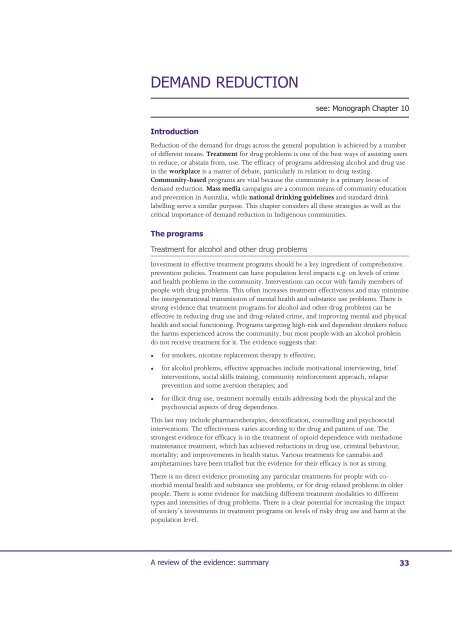Summary - Department of Health and Ageing
Summary - Department of Health and Ageing
Summary - Department of Health and Ageing
You also want an ePaper? Increase the reach of your titles
YUMPU automatically turns print PDFs into web optimized ePapers that Google loves.
Reduction <strong>of</strong> the dem<strong>and</strong> for drugs across the general population is achieved by a number<br />
<strong>of</strong> different means. Treatment for drug problems is one <strong>of</strong> the best ways <strong>of</strong> assisting users<br />
to reduce, or abstain from, use. The efficacy <strong>of</strong> programs addressing alcohol <strong>and</strong> drug use<br />
in the workplace is a matter <strong>of</strong> debate, particularly in relation to drug testing.<br />
Community-based programs are vital because the community is a primary locus <strong>of</strong><br />
dem<strong>and</strong> reduction. Mass media campaigns are a common means <strong>of</strong> community education<br />
<strong>and</strong> prevention in Australia, while national drinking guidelines <strong>and</strong> st<strong>and</strong>ard drink<br />
labelling serve a similar purpose. This chapter considers all these strategies as well as the<br />
critical importance <strong>of</strong> dem<strong>and</strong> reduction in Indigenous communities.<br />
<br />
<br />
Investment in effective treatment programs should be a key ingredient <strong>of</strong> comprehensive<br />
prevention policies. Treatment can have population level impacts e.g. on levels <strong>of</strong> crime<br />
<strong>and</strong> health problems in the community. Interventions can occur with family members <strong>of</strong><br />
people with drug problems. This <strong>of</strong>ten increases treatment effectiveness <strong>and</strong> may minimise<br />
the intergenerational transmission <strong>of</strong> mental health <strong>and</strong> substance use problems. There is<br />
strong evidence that treatment programs for alcohol <strong>and</strong> other drug problems can be<br />
effective in reducing drug use <strong>and</strong> drug-related crime, <strong>and</strong> improving mental <strong>and</strong> physical<br />
health <strong>and</strong> social functioning. Programs targeting high-risk <strong>and</strong> dependent drinkers reduce<br />
the harms experienced across the community, but most people with an alcohol problem<br />
do not receive treatment for it. The evidence suggests that:<br />
<br />
<br />
for smokers, nicotine replacement therapy is effective;<br />
for alcohol problems, effective approaches include motivational interviewing, brief<br />
interventions, social skills training, community reinforcement approach, relapse<br />
prevention <strong>and</strong> some aversion therapies; <strong>and</strong><br />
for illicit drug use, treatment normally entails addressing both the physical <strong>and</strong> the<br />
psychosocial aspects <strong>of</strong> drug dependence.<br />
This last may include pharmacotherapies, detoxification, counselling <strong>and</strong> psychosocial<br />
interventions. The effectiveness varies according to the drug <strong>and</strong> pattern <strong>of</strong> use. The<br />
strongest evidence for efficacy is in the treatment <strong>of</strong> opioid dependence with methadone<br />
maintenance treatment, which has achieved reductions in drug use, criminal behaviour,<br />
mortality; <strong>and</strong> improvements in health status. Various treatments for cannabis <strong>and</strong><br />
amphetamines have been trialled but the evidence for their efficacy is not as strong.<br />
There is no direct evidence promoting any particular treatments for people with comorbid<br />
mental health <strong>and</strong> substance use problems, or for drug-related problems in older<br />
people. There is some evidence for matching different treatment modalities to different<br />
types <strong>and</strong> intensities <strong>of</strong> drug problems. There is a clear potential for increasing the impact<br />
<strong>of</strong> society’s investments in treatment programs on levels <strong>of</strong> risky drug use <strong>and</strong> harm at the<br />
population level.

















